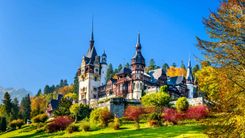When we reach Snagov we have to cross a footbridge, because the monastery is built on a small island in a lake. There used to be a pontoon bridge connecting the island with the mainland during the nineteenth century, when the monastery was used as a prison. Not long after it was built, it collapsed when a parade of enchained convicts was crossing. They all drowned. I stare at the murky waters below me, green with algae. “Sometimes you can see the wooden slats of the old bridge in the shallows”, says Gabriel.
Snagov monastery itself is minute. There is only one monk and one small church, last rebuilt in 1512 by Prince Neagoe Basarab, whose portrait adorns the wall facing the iconostasis. In front of the altar, there is a clean, unmarked tombstone on the floor with fresh flowers and a portrait of Vlad the Impaler. Typically, when the tomb was excavated in 1933, no body was found inside.
Small the monastery may be, but so strong is the Dracula myth that it’s become the most popular sight to visit outside of Bucharest. Entry into the church is just 15lei (£3) – but it costs 20 Euros to take photos; monks in newly capitalist Romania are beginning to comprehend rather well the law of supply and demand. This could be why a monastery south of Bucharest wants to buy in too.








